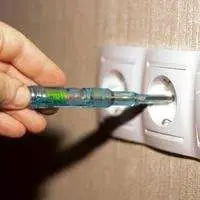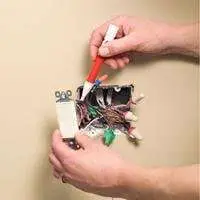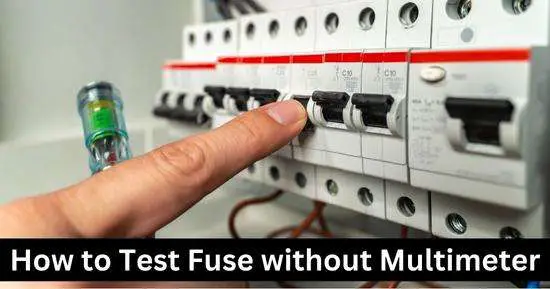It is necessary to test a fuse so your appliances can be safe. A fuse protects a circuit from the overloading of current. You can test a fuse without a multimeter if you don’t have one. You’ll need a tester screwdriver, a non–contact voltage tester, or a bulb socket to test a fuse.
When the current exceeds the maximum limit, the fuse wire will melt and breaks the circuit to protect your appliances.
A fuse is an electrical gadget that controls overcurrent. Hardware with an expired fuse can have an uncontrolled supply that can harm its performance and health.
This post will teach you different methods to test a fuse without a multimeter.
Table of Contents
ToggleHow to test a fuse without a multimeter
There are several ways of testing a fuse without a multimeter.
- Test 1: Visually inspect for damaged fuse wire.
- Test 2: Put the live wire on one side of the fuse and the tester screwdriver on the other, and check if the bulb glows.
- Test 3: Wire a bulb socket with a battery, place the fuse between the battery’s live wire and bulb socket wire and check if the bulb glows.
- Test 4: Check if the non-contact voltage tester blinks or beeps along the fuse attached to the live wire.
Below, in this article, we will go through all the tests step–by–step.
Step 1: Safety Tips
As we have to work with high voltage wires, it’s essential to have safety measures.
- First of all, wear gloves.
- Use a battery or AC (outlet).
- Turn off the power supply while attaching wires.
- Use alligator clips for ease.
Step 2: Visually Inspect
To test a fuse, visually inspect whether the fuse wire is broken. This fuse wire (made of lead or tin) is responsible for passing current in a circuit and melts (breaks) when current overloads in the circuit.
The transparent glass makes it easy to decide if a fuse wire (alloy) is fine or broken.
However, if you have a ceramic fuse, it’s difficult to decide if the fuse is good or expired.
Test 1: Using Voltage Tester (Screwdriver).
- A voltage tester detects current in wires. We will test the fuse by connecting one end to a live wire and the other to a voltage tester screwdriver.
- If the bulb in the tester screwdriver glows, it means that the current is passing through the fuse. Fuse wire is fine (able to pass current), and you can use it in a circuit.
Test 2: Using a light bulb Socket
You can use a light bulb socket without a multimeter to test a fuse.
- Set up a bulb in a socket.
- Make a circuit by connecting the battery’s live wire on one side of the fuse.
- Connect the other end of the fuse with the bulb socket wire.
- Connect the second wire of the light socket to the ground wire (black wire in battery) of the circuit. The ground wire will complete the circuit.
- If the fuse you’re testing is OK, the bulb will glow because the current passes through the fuse to the bulb.
- However, if the fuse wire(thin metal allay) is damaged, the bulb will not glow, indicating a broken path (fuse wire) stopping the current from reaching the bulb.
Test 3: Using a non-contact voltage tester
A non–contact voltage tester is another option to test a fuse without a multimeter. A non-contact voltage tester detects current in wires or any live part of a circuit with magnetic waves.
- Attach one metal end of the fuse to a live wire and turn on the power supply.
- Take a non–contact voltage tester and pass it through the fuse.
- If the fuse is good, the voltage detector will beep or blink, which indicates that voltage has been detected passing through the fuse.
- However, if the voltage tester doesn’t blink or remain stable while passing through the fuse. The fuse wire is broken, and the current is not passing through it.
How to tell if a ceramic fuse is blown without a multimeter?
You can’t visually examine a ceramic fuse due to its not transparent body. That’s why it’s necessary to test a ceramic fuse with or without a multimeter.
Use a voltage tester, bulb socket, or non-contact voltage tester to check if a fuse is blown or not without a multimeter.
- Attach the bulb socket to the battery terminals. Now place your fuse between the live battery terminal and bulb socket wire. If the bulb glows, your ceramic fuse is OK; otherwise, the fuse is weak.
- In the same way, connect one end of the fuse with a live wire and the other end to the voltage tester. If the tester glows fuse is fine and passing current in the circuit. Same as if you pass a non-contact voltage tester through the fuse connected to live wire; the tester will blink or beep.
Follow the complete step-by-step guide above.
How to check fuses without removing them
You’ll need a multimeter to check a fuse without removing it from the circuit. A multimeter will check the continuity between both metallic ends of the fuse, determining the fuse wire.
Set your multimeter to continuity or resistance setting. Attach both probes (black & red) at both metal ends of the fuse.
If the fuse wire is fine, the multimeter will show continuity through resistance reading or beep.
However, If the fuse wire is broken, the multimeter will read OL, which means an open line or incomplete current path.
Conclusion
Hopefully, you figured out how to test fuse without a multimeter using straightforward techniques. Visually Inspect, then use a tester screwdriver, non-contact voltage tester, or bulb socket to check whether the current is passing through the fuse.
Share your experience in the comment section
Related Guide:






